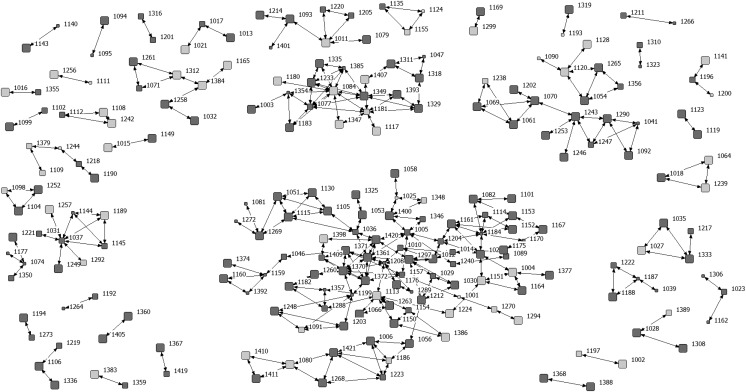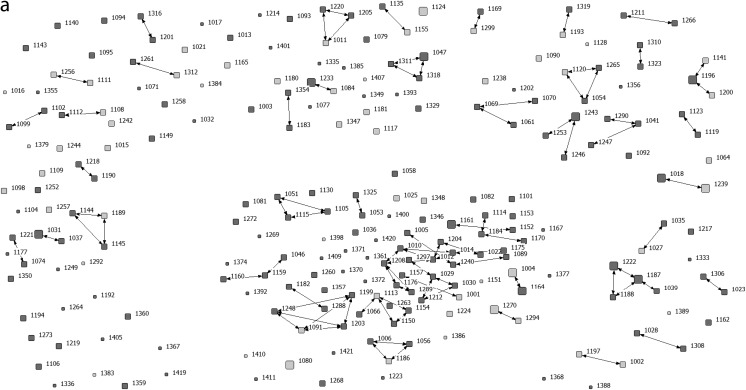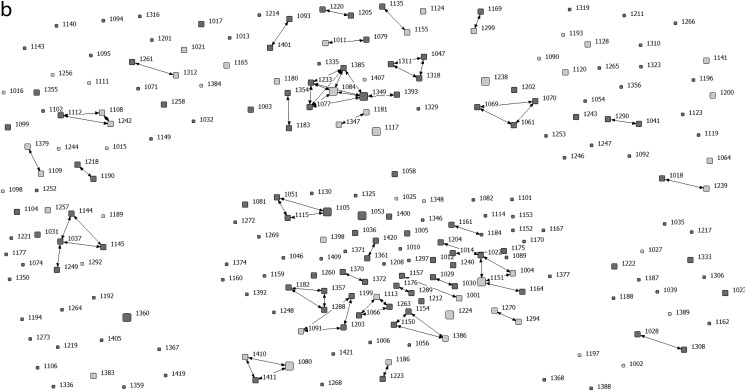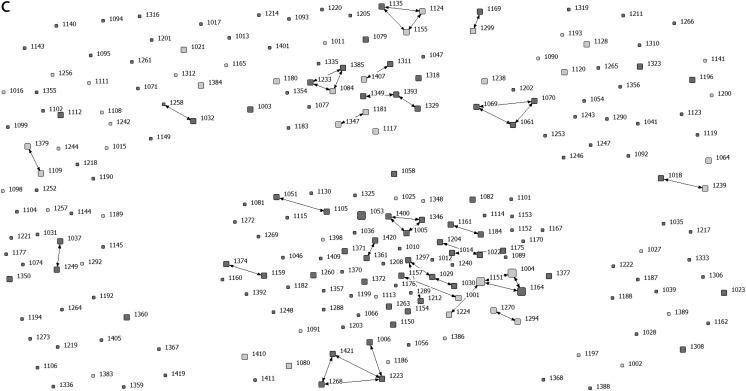Abstract
We investigated whether “hidden” (or unobserved) social networks were evident in a 2011 physical activity behavior change intervention in Belfast, Northern Ireland. Results showed evidence of unobserved social networks in the intervention and illustrated how the network evolved over short periods and affected behavior. Behavior change interventions should account for the interaction among participants (i.e., social networks) and how such interactions affect intervention outcome.
Complex behavior change interventions have unintentional and unobserved consequences and effects that must be captured to help us fully understand mechanisms of behavior change.1 For example, many interventions do not account for the interaction among participants (i.e., social networks) and how such interactions affect intervention outcome.2
Berkman3 illustrates how social networks affect health through social interactions at the microlevel affecting behavior at the meso- and macrolevels, and previous research has helped us understand the effect of social networks on a range of health behaviors.4–13
We argue that “hidden” (or unobserved) social networks are inherent in behavior change interventions, particularly in cluster trials, and hypothesize that such networks affect the outcome of behavior change interventions. We investigated (1) whether social networks were evident in a physical activity behavior change intervention, and (2) if evident, what the characteristics and evolution of the network structure were over time.
METHODS
We collected objective social network and physical activity data concurrently over a 12-week period from a quasi-experimental trial of a financial incentive intervention (in Belfast, Northern Ireland, 2011).14 We placed sensors (near field communication readers) along footpaths and in the gym in a workplace environment. Employees scanned a card containing a radio frequency identification tag at sensors when undertaking physical activity, such as walking, which created a timestamp (date, time in seconds, and location) that logged their activity.
The timestamp data facilitated our identification of participants’ social networks. We derived the criteria for inferring participants’ social networks from timestamps (1) on the same day; (2) at the same sensor (at 3 or more co-occurrences); and (3) within 30 seconds (which signified co-occurrences of physical activity behavior and enabled us to capture the social interactions of more than 2 people; data available as a supplement to the online version of this article at http://www.ajph.org).15,16 We calculated the minutes of physical activity by aggregating the minutes between the timestamp data at each scanned sensor.
We calculated the network density (proportion of ties in the network), degree centrality (number of ties in a node), triadic census (structure involving 3 people), total number of social ties (number of co-occurrences of card swipes between at least 2 participants), and the Jaccard index, a measure of network stability (proportion of stable ties to ties at each time point) to describe the network structure17 using UCINet 618 and Netdraw.19
RESULTS
Of the 406 participants, 225 engaged in physical activity involving social interactions with at least 1 other participant (as opposed to those doing physical activity alone or not at all). We inferred 5578 social interactions over the 12-week intervention, with 282 distinct pairings of participants, demonstrating clear evidence of hidden social networks within the intervention.
The network graph (Figure 1) illustrates that certain participants formed clear physical activity clusters, including cliques of dyadic (19 groups of 2 people) and triadic (9 groups of 3 people) structures. On average, participants engaged in physical activity with 1.4 (SD = 1.8) others (mean degree of centrality).
FIGURE 1—
Network graph showing the derived social networks aggregated over the 12-week intervention period and their relation to achieved level of within-trial physical activity: Belfast, Northern Ireland, 2011.
Note. Node size indicates physical activity level: small nodes indicate no physical activity (0 minutes/week), medium nodes indicate some physical activity (1–149 minutes/week), and large nodes indicate sufficient physical activity (≥ 150 minutes/week). Light grey nodes indicate men; dark grey nodes indicate women. The mean degree centrality is 1.4 (SD = 1.8) and ranges from 0 to a maximum of 10, meaning that the average participant (from all 406 participants) engaged in physical activity with 1.4 others.
Figure 2 demonstrates the evolution of the social network structure over time. Dyadic and triadic structures are evident at each time point, illustrating a sustained pattern of participants walking with the same participants. The Jaccard index showed an increase in stability from a range of 8%–11% in weeks 1 and 2 to a range of 36%–45% in the last 4 weeks of the intervention, suggesting that walking “buddies,” once established, remained stable. Results suggest that those engaged in physical activity with others maintained higher activity levels (i.e., 150 min/wk) throughout the intervention, which is reflected by the larger node size.
FIGURE 2—
Snapshots of network graphs illustrating the evolving dynamic nature of social networks and their relation to achieved level of within-trial physical activity occurring at (a) week 1 of the intervention, (b) week 6 of the intervention, and (c) week 12 of the intervention: Belfast, Northern Ireland, 2011.
Note. Node size indicates physical activity level: small nodes indicate no physical activity (0 minutes/week), medium nodes indicate some physical activity (1–149 minutes/week), and large nodes indicate sufficient physical activity (≥ 150 minutes/week). Light grey nodes indicate men; dark grey nodes indicate women. Social ties were determined by the number of co-occurrences of card swipes between at least 2 participants during physical activity. The Jaccard Index is the proportion of stable ties to ties that exist.
DISCUSSION
Results provide evidence of hidden social networks in a complex behavior change intervention and illustrate how the network evolved over short periods and affected behavior. Findings demonstrate that those who exercised in pairs or a group maintained higher levels of physical activity than do those who did not. Therefore, harnessing and using such networks could help promote and maintain behavior change. This may involve changing the structure or functioning of existing networks or the purposeful development of new social networks. Further, analyses of interventions that take explicit account of previously unobserved hidden social networks might better uncover mediators and pathways of initiation and maintenance of behavior change.
Social networks have been identified as an important modifiable mediator of physical activity behavior change20; however, we know very little about how to use and exploit such networks in behavior change interventions.21 To our knowledge, this is the first study to provide explicit evidence of social networks inherent in behavior change interventions. We argue that these hidden social networks have typically been overlooked, unobserved, and subsequently underused in behavior change interventions. However, our analyses were limited to the influence of those who were enrolled in the physical activity intervention, and we did not attempt to model the broader social networks that exist outside the workplace.
The collection of such data is relatively straightforward and could (and should) be incorporated into future behavior change interventions for a range of behaviors, including physical activity, diet, alcohol, and smoking. Further, emerging technologies and social media enable unobserved social interactions in behavior change interventions to (1) be objectively measured, (2) capture social interactions directly related to the health behavior under investigation, (3) be measured longitudinally, and (4) be monitored, manipulated (if appropriate), and analyzed in real time and help us better understand the effect of inherent social networks within behavior change interventions.
Whether such networks could be harnessed to support a successful public health intervention depends on a range of practical and theoretical issues that have yet to be studied.22–24 For example, which psychosocial and behavior change theories plausibly underpin the intervention design and how social networks can be optimally designed to generate, accelerate, and maintain behavior change?
Acknowledgments
This research was supported by the National Prevention Research Initiative (grant G0802045), the Department for Employment and Learning, Northern Ireland (grant M6003CPH), and the United Kingdom Clinical Research Collaboration, Centre of Excellence for Public Health Northern Ireland. R. F. H is funded by a National Institute for Health Research Career Development Fellowship. H. M. is funded by a Medical Research Council Methodology Research Fellowship.
The authors thank Intelligent Health Ltd. for its contribution to the technology used in the Physical Activity Loyalty Card Scheme.
Human Participant Protection
The study was approved by the Research Ethics Committee of the School of Medicine, Dentistry and Biomedical Sciences, Queen’s University Belfast, Northern Ireland. All participants provided informed written consent before participation.
References
- 1.Grant A, Treweek S, Dreischulte T, Foy R, Guthrie B. Process evaluations for cluster-randomized trials of complex interventions: a proposed framework for design and reporting. Trials. 2013;14:15. doi: 10.1186/1745-6215-14-15. [DOI] [PMC free article] [PubMed] [Google Scholar]
- 2.Gesell SB, Barkin SL, Valente TW. Social network diagnostics: a tool for monitoring group interventions. Implement Sci. 2013;8:116. doi: 10.1186/1748-5908-8-116. [DOI] [PMC free article] [PubMed] [Google Scholar]
- 3.Berkman LF, Glass T. Social integration, social networks, social support, and health. In: Berkman LF, Kawachi I, editors. Social Epidemiology. New York: Oxford University Press; 2000. pp. 143–145. [Google Scholar]
- 4.Macdonald-Wallis K, Jago R, Sterne JA. Social network analysis of childhood and youth physical activity: a systematic review. Am J Prev Med. 2012;43(6):636–642. doi: 10.1016/j.amepre.2012.08.021. [DOI] [PubMed] [Google Scholar]
- 5.Maturo CC, Cunningham SA. Influence of friends on children’s physical activity: a review. Am J Public Health. 2013;103(7):e23–e38. doi: 10.2105/AJPH.2013.301366. [DOI] [PMC free article] [PubMed] [Google Scholar]
- 6.Sawka KJ, McCormack GR, Nettel-Aguirre A, Hawe P, Doyle-Baker PK. Friendship networks and physical activity and sedentary behavior among youth: a systematized review. Int J Behav Nutr Phys Act. 2013;10:130. doi: 10.1186/1479-5868-10-130. [DOI] [PMC free article] [PubMed] [Google Scholar]
- 7.Suzuki E, Takao S, Subramanian SV, Doi H, Kawachi I. Work-based social networks and health status among Japanese employees. J Epidemiol Community Health. 2009;63(9):692–696. doi: 10.1136/jech.2008.082453. [DOI] [PubMed] [Google Scholar]
- 8.Tamers SL, Beresford SA, Cheadle AD, Zheng Y, Bishop SK, Thompson B. The association between worksite social support, diet, physical activity and body mass index. Prev Med. 2011;53(1–2):53–56. doi: 10.1016/j.ypmed.2011.04.012. [DOI] [PMC free article] [PubMed] [Google Scholar]
- 9.Buller DB, Morrill C, Taren D et al. Randomized trial testing the effect of peer education at increasing fruit and vegetable intake. J Natl Cancer Inst. 1999;91(17):1491–1500. doi: 10.1093/jnci/91.17.1491. [DOI] [PubMed] [Google Scholar]
- 10.Valente TW, Hoffman BR, Ritt-Olson A, Lichtman K, Johnson CA. Effects of a social-network method for group assignment strategies on peer-led tobacco prevention programs in schools. Am J Public Health. 2003;93(11):1837–1843. doi: 10.2105/ajph.93.11.1837. [DOI] [PMC free article] [PubMed] [Google Scholar]
- 11.Valente TW, Fosados R. Diffusion of innovations and network segmentation: the part played by people in promoting health. Sex Transm Dis. 2006;33(suppl 7):S23–S31. doi: 10.1097/01.olq.0000221018.32533.6d. [DOI] [PubMed] [Google Scholar]
- 12.Valente TW, Pumpuang P. Identifying opinion leaders to promote behavior change. Health Educ Behav. 2007;34(6):881–896. doi: 10.1177/1090198106297855. [DOI] [PubMed] [Google Scholar]
- 13.Christakis NA, Fowler JH. The spread of obesity in a large social network over 32 years. N Engl J Med. 2007;357(4):370–379. doi: 10.1056/NEJMsa066082. [DOI] [PubMed] [Google Scholar]
- 14.Hunter RF, Tully MA, Davis M, Stevenson M, Kee F. Physical activity loyalty cards for behavior change: a quasi-experimental study. Am J Prev Med. 2013;45(1):56–63. doi: 10.1016/j.amepre.2013.02.022. [DOI] [PubMed] [Google Scholar]
- 15.Lauw HW, Lim EP, Tan TT, Pang H. Social network discovery by mining spatio-temporal events. Comput Math Organ Theory. 2005;11:97–118. [Google Scholar]
- 16.Preciado P, Snijders TAB, Burk WJ, Stattin H, Kerr M. Does proximity matter? Distance dependence of adolescent friendship. Soc Networks. 2012;34(1):18–31. doi: 10.1016/j.socnet.2011.01.002. [DOI] [PMC free article] [PubMed] [Google Scholar]
- 17.Hanneman RA, Riddle M. Introduction to Social Network Methods. Riverside: University of California; 2005. [Google Scholar]
- 18.Borgatti SP, Evereyy MG, Freeman LC. UCINet 6 for Windows: Software for Social Network Analysis. [computer program] Cambridge, MA: Analytic Technologies; 2002. [Google Scholar]
- 19.Borgatti SP. NetDraw: Graph Visualization Software. [computer program] Cambridge, MA: Analytic Technologies; 2002. [Google Scholar]
- 20.Bauman AE, Reis RS, Sallis JF et al. Correlates of physical activity: why are some people physically active and others not? Lancet. 2012;380(9838):258–271. doi: 10.1016/S0140-6736(12)60735-1. [DOI] [PubMed] [Google Scholar]
- 21.Valente TW. Network interventions. Science. 2012;337(6090):49–53. doi: 10.1126/science.1217330. [DOI] [PubMed] [Google Scholar]
- 22.Shapiro RB, Ossorio PN. Research ethics. Regulation of online social network studies. Science. 2013;339(6116):144–145. doi: 10.1126/science.1219025. [DOI] [PubMed] [Google Scholar]
- 23.Li DC. Online social networking acceptance: a social perspective. Internet Res. 2011;21(5):562–580. [Google Scholar]
- 24.Hugl U. Reviewing person’s value of privacy of online social networking. Internet Res. 2011;21(4):384–407. [Google Scholar]






